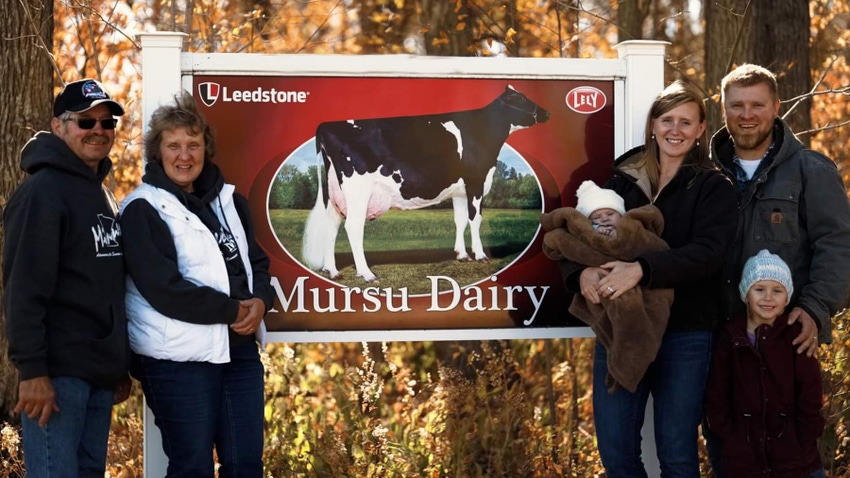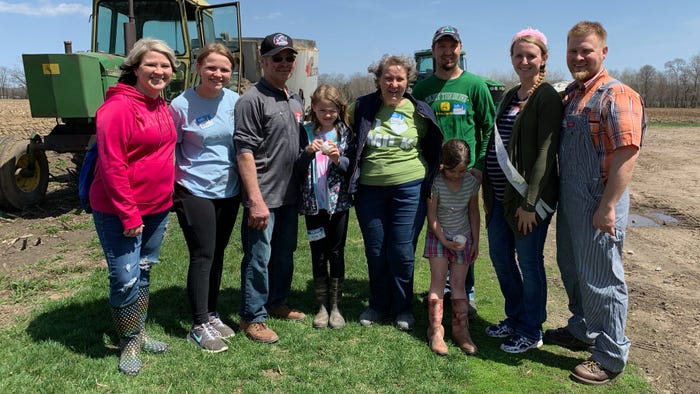
Dairy has been the backbone of the Mursu family for decades, as Tom Mursu’s parents started milking on the farm, near New York Mills, Minn., in the mid-1950s.
“Dad started off milking 11 cows by hand,” Tom says. “He had a full-time day job. He’d milk in the morning before he went to work, drop off the milk cans at the local creamery, went to work to build silos all day, then came home and milked the cows again.”
Holsteins have been the constant at Mursu Dairy, but the operation has evolved over time. Milking by hand gave way to milking machines, and 10 years ago the 100-year-old, tiestall, hip-roof barn gave way to a freestall barn.

FAMILY TRIPS: The Mursu family has opened their farm for class trips for their daughter Bridget’s (far left) kindergarten class, starting when Tom and Tammy’s granddaughter Audrey (second from left) was in her mother’s (Bridget’s) class. Audrey, now a high school FFA member, helps with the class visits. Also pictured are Tom (third from left); granddaughter Kylie; Tammy; son Trent; son Jeremy’s wife, Vanessa; and Jeremy. Granddaughter Alyssa is in front of Trent. (Courtesy of Minnesota Milk Producers Association)
“It had served its purpose,” Tom says, speaking of the century-old barn, “and it didn’t really pay to put what I would call new money into old money.”
Tom and Tammy and their son Jeremy milked about 60 cows in that 36-stall barn, “and it was very labor-intense.”
New beginnings
The new freestall barn and the addition of two Lely robotic milkers allow for around-the-clock milking of the family’s 150 Holsteins. Though the Mursus spend a lot of time in the barns monitoring the cows and equipment, the robotic milkers allow the family to step away.
“That was definitely a switch,” Tom says, “In the old facility, you didn’t leave until everything was done. Whereas now, the robot is milking 24/7, and you have to leave sometime.”
“Robots lighten the labor, but it still requires time,” says Jeremy, adding that the addition of the robots did not require additional farmhands even though they increased the milking herd.
Jeremy tends to the feed rations and stays on top of the herd’s genetics that have got the dairy to a rolling herd average of 26,500 pounds of milk. On the average, cows are kept for about three lactations. The computers backing the robotic system track individual cow’s milk production — and much more.
Cows enter the milking station on their own, as many times as they choose, but they may not be milked each time.
“Our goal is to collect at least 28 to 30 pounds of milk per visit,” Jeremy says. “We need to be efficient with our time, so we don’t want to milk a cow every two hours.” Each cow is identified by a computer chip on her collar.
Cows entering the robotic milker receive an “individualized amount of pellets or concentrate feed based on how much they milk,” Jeremy says. Cows that give more milk get more feed because “they deserve it. … Some cows get milked four times a day. Some cows barely get milked twice a day. And that’s just fine.”
In addition to identifying the specific cow, the transponder on her collar also keeps track of the time spent chewing her cud [herd average currently is 530 minutes per day], “so if she deviates down too much from that or what she normally does, that will show up as an alert that this cow is not eating normal,” Jeremy says.
The transponder also acts as a pedometer, monitoring each cow’s movements. “On the days when she’s in heat, she might spike because she’s way more active in the barn,” Jeremy says. “Also, vice versa — if she’s sick, she’s not moving around as much, and her footsteps can be down.”
Mursu Dairy sells its milk to Land O’Lakes, but due to strategic and economic milk trades, fluid milk is delivered to Bongards facility in Perham, Minn., to be made into cheese.
In addition to the 150 cows being milked, the Mursus also raise their replacement heifers, meaning they go through a lot of feed. They raise nearly 500 acres of alfalfa and high-moisture corn, and drought hasn’t been the family’s friend. “We bought a lot of feed this past year [2021]. We had quite a severe drought up here,” Tom says. “Feed costs were high, but we were fortunate that the milk price was in our favor also.”
Last year’s crop allowed the Mursus to build up feed inventory, “but the milk price is softer, so that doesn’t help,” Tom says. What 2023 holds is yet to be seen, as “we went into the winter very dry,” Tom says. “We did not do any tillage because it was so dry last fall.”
Mursu Dairy was awarded the 2022 Producer of the Year by the Minnesota Milk Producers Association prior to the group’s annual meeting in February.
Open barn doors
Beginning with the new barn in 2013, the Mursus have had an open door. With their daughter Bridget being a kindergarten teacher in the local school, and their oldest granddaughter, Audrey, in kindergarten in 2014, it was only fitting for the class to come to the farm for a field trip.
Kindergarten class visits have continued since then, and Audrey is now a high school FFA member helping with these field trips. The class is divided in into eight groups, so each can rotate to all the different stations. Kindergartners get to visit the barn and see the robots in action; visit the milk house and the feed station, where the children make their own total mixed ration mix using various feeds that are put in a big tub and stirred. The students also get to see calves, a baby donkey, chicks, bunnies, kittens and baby goats.
In addition to the annual kindergarten visits, the Mursus open their farm to other groups such as a technology class, a field day with the University of Minnesota, nursing home residents and Lions clubs.
The family sees these farm visits as a way to inform the public about modern agriculture.
“There are a limited number of dairy farmers — and if somebody doesn’t reach out, how are they [the public] going to have a chance to see what a dairy farm is like?” Tammy says. “We do what we can in our corner of the world.”
About the Author(s)
You May Also Like






